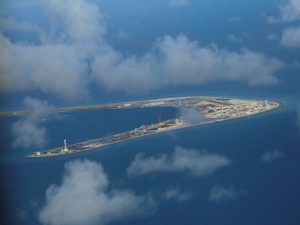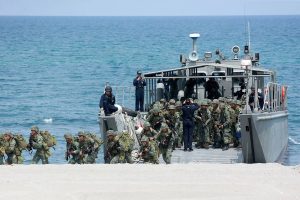Philippine president Ferdinand Marcos Jr. says the presence of US troops was in response to China’s moves…reports Asian Lite News
The Philippine president said Monday his administration has no plan to give the United States access to more Philippine military bases and stressed that the American military’s presence in several camps and sites so far was sparked by China’s aggressive actions in the disputed South China Sea.
President Ferdinand Marcos Jr., who took office in 2022, allowed American forces and weapons access to four additional Philippine military bases, bringing to nine the number of sites where US troops can rotate indefinitely under a 2014 agreement.
The Biden administration has been strengthening an arc of security alliances in the region to better counter China, a move that dovetails with Philippine efforts to shore up its external defense, especially in the South China Sea.
Marcos’ decision last year alarmed China because two of the new sites were located just across from Taiwan and southern China. Beijing accused the Philippines of providing American forces with staging grounds, which could be used to undermine its security.
“The Philippines has no plans to create any more bases or give access to any more bases,” Marcos said, without elaborating in response to a question during a forum with Manila-based foreign correspondents.
Asked if he was concerned that allowing the US military access to Philippine bases had provoked Chinese actions in the South China Sea, Marcos said the presence of US troops was in response to China’s moves.
“These are reactions to what has happened in the South China Sea, to the aggressive actions that we have had to deal with,” he said, mentioning Chinese coast guard vessels using water cannons and lasers to deter Philippine ships from the area Beijing claims as its own.
He also mentioned collisions, blocking of Filipino fishermen and sea barriers to block ships from Scarborough Shoal, which lies in the Philippine economic zone.
Under Marcos, the Philippines has adopted a strategy of publicizing the incidents by allowing journalists to board its patrol ships to witness China’s assertive actions.
“It is crucial that the media … continue to expose these actions that not only threaten the peace and stability of the region but also undermine the rules-based order that has underpinned global development and prosperity over the previous century,” Marcos said.
China has blamed the Philippines for sparking the confrontations by intruding into what it says were Chinese territorial waters and reneging on an alleged agreement to pull away an old Philippine navy ship, which now serves as Manila’s territorial outpost in the disputed Second Thomas Shoal.
Marcos said he was not aware of any such deal, and added that he considers the deal rescinded — if it ever existed.
Last week, President Joe Biden renewed Washington’s “ironclad” commitment to defend Pacific allies in a summit with Marcos and Japanese Prime Minister Fumio Kishida at the White House. He reiterated that the US is obligated to defend the Philippines if its forces, aircraft or ships come under an armed attack.
Asked when the 1951 Mutual Defense Treaty between the US and the Philippines could be invoked amid territorial hostilities between China and the Philippines, Marcos cited Defense Secretary Lloyd Austin as saying that could happen “if any Filipino serviceman is killed on an attack from any foreign power.”

US deploys midrange missile system in Indo-Pacific
The US Army has deployed its new Typhon midrange ground-based missile launcher to the Indo-Pacific region for the first time, for joint military exercises in the northern Philippines — a move likely to unnerve China.
In a statement released Monday, the U.S. Army said it had sent the launcher, which is capable of firing Tomahawk cruise missiles and SM-6 missiles, to the Northern Luzon area of the Philippines for the Salaknib 2024 joint military exercises.
“In a historic first, the 1st Multi-Domain Task Force successfully deployed the Mid-Range Capability (MRC) missile system to Northern Luzon, Philippines, on April 11, 2024, as part of Exercise Salaknib 24,” the statement said. “This landmark deployment marks a significant milestone for the new capability while enhancing interoperability, readiness, and defense capabilities in coordination with the Armed Forces of the Philippines.”
While the army did not give an exact location where the launcher was deployed for the exercises, the US military currently has access to five different sites on the island of Luzon, the Philippine archipelago’s largest and most populous island.
Considering that Tomahawk missiles have a range of more than 1,600 kilometers, any deployment there would cover not only the entire Luzon Strait, the launcher could also hit portions of the Chinese coast as well as various People’s Liberation Army bases in the disputed South China Sea and its periphery.
Gen. Charles Flynn, the US Army’s commanding general in the Pacific, recently reiterated comments he made in December that the United States would deploy an intermediate-range missile launcher to the region.
ALSO READ: India is our strategic partner, world’s largest democracy: US






